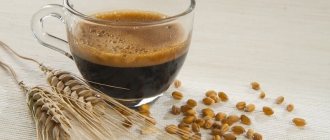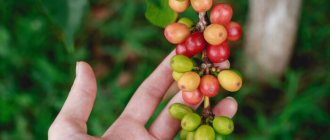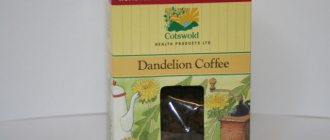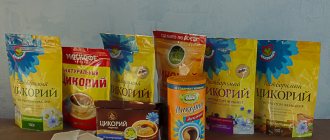Coffee... It's hard to find another drink that is so versatile. We start our mornings with a fragrant cup, we think about coffee when we need to fight off sleep and restore strength; friendly gatherings and romantic dates are indispensable without this drink. But such enormous popularity also gives rise to many myths. So what really is coffee for a person: salvation and pleasure or a most dangerous enemy? Let's look for the answer to this question together.
Origin: legends and scientific facts
Search the World Wide Web with the query “Origin of coffee” and the search engine will return several million pages with stories on this topic. And in many cases, the date when humanity first tried this drink “walks” within several centuries. Somewhere they call it the 5th century, somewhere the 11th or 13th century. And the most famous legend about coffee dates us back to the year 850. According to legend, one day the Ethiopian shepherd Kaldi noticed that his goats, having tasted the dark green leaves and red fruits of one of the bushes, began to behave very strangely. The animals jumped and frolicked. The shepherd tried the berries himself, and soon learned about the powerful effect of coffee beans.
Content:
- Origin: legends and scientific facts
- What types and varieties are there?
- Most popular types
- The benefits and harms of coffee
- A Few Hard Facts: Potential Coffee Dangers
- Is a caffeine-free drink healthy?
- Application in cosmetology
And now some facts from researchers. Scientists believe that the coffee plant first appeared on the plateau of central Ethiopia, in a region known as Kaffe. By the way, in the traditions of the Ethiopian Galla tribe, the tradition of consuming “energy balls” made from animal fats and soaked coffee berries has been preserved to this day.
Over time, the culture spread to the lands of Yemen, Cairo, and Mecca. On the Arabian Peninsula, coffee became the favorite fruit of monks. They consumed an infusion of berries and leaves to stay alert during hours of nightly prayer. It is believed that they were the first to think of roasting and grinding grains.
By the 16th century, coffee had become known in Turkey, and the product quickly spread throughout the Ottoman Empire. In the 17th century, Venetian merchants brought aromatic grains to Europe, but the Catholic Church greeted the drink with caution. Advisers urged Pope Clement VIII to declare coffee the “devilish” drink. But the Pope refused and he himself got hooked on the Arabic energy drink. And when Europe became captivated by the coffee aroma, Arab traders, in order to maintain a monopoly on the cultivation and supply of goods, doused them with boiling water before sending the beans to Europe.
It is believed that the very first coffee shop appeared in Istanbul, where coffee became an integral part of the local culture.
Although, according to another assumption, the first establishments where the drink was brewed appeared in Mecca. The first European coffee shops appeared in Venice, but none of them have survived to this day. But in the German city of Leipzig, today you can visit the oldest Coffee House in Europe, opened back in 1694.
Wiktionary
- Morphological and syntactic properties
coffee
Noun, inanimate, masculine, indeclinable (declension type 0 according to A. Zaliznyak’s classification). It is also acceptable to use it as a noun. neuter. Root: -coffee-.
- Pronunciation
MFA: units h. [?ko.f??], pl. h [?ko.f??] Pronunciation example
- Orthoepy
Outdated pronunciation: [?ko.f?]
- Meaning
- food product, coffee beans, whole or ground ? Grind coffee. ? Chocolate covered coffee. ? You can import up to 1 kg of coffee, up to 5 liters of alcoholic beverages and up to 20 packs of cigarettes duty free. “Across Borders” // “Behind the Wheel”, 2004 (quote from the National Corpus of the Russian Language, see References)
- an aromatic, invigorating, dark-colored drink, usually consumed hot, made from roasted coffee beans ? And from them two boys came out in smart clothes, and, having come to the envoy, they danced and threw themselves over their heads, then the Derbent saltan and others asked the envoy to stop near one of the gardens, which is right next to the settlements, and brought coffee and, having drunk, went to the city . “Correspondence and affairs during the embassy of Artemy Volynsky,” 1716-1718 (quote from the National Corpus of the Russian Language, see References) ? Then the father quickly finished his coffee and retired to his office. Vera Belousova, “The Second Shot”, 2000 (quote from the National Corpus of the Russian Language)
- Synonyms
- Kofiy (simple)
- Hypernyms
- product, grains
- drink, drink
- Hyponyms
- Arabica, Mocha
- Espresso, Cappuccino, Glace, Latte, Mocha, Ristretto
- Related words
- diminutive-affectionate forms: coffee pot, coffee pot, coffee pot
- other nouns: Coffee pot, Coffee maker, Coffee grinder, Coffee shop, Caffeine, Coffee
- adjectives: coffee, caffeinated
- verbs: to have coffee, to have coffee
- Etymology
From Arabic ???? (qahwa; originally meant a type of wine). In a number of European languages, the word is borrowed. through. Turkish kahve. Further origins are unknown; it is possible that qahwah came from the name of the Ethiopian region of Caffa, the birthplace of the coffee tree (in Caffa itself, coffee is called “buno” or “bunna”). Russian borrowed coffee via English coffee or Dutch koffie from tour.
What types and varieties are there?
Coffee is an evergreen tropical shrub with white flowers that have a scent reminiscent of jasmine. The coffee beans we are used to are contained inside red berries - two in each.
Every morning, millions of people on the planet start their day with a cup of invigorating coffee - a drink made from roasted and crushed seeds of the coffee plant. There are many varieties of coffee, but they all represent only 2 product categories: Arabica and Robusta.
Arabica is a species native to the Arabian Peninsula. It is the most ancient of the cultivated ones, and the most popular in the modern world (it occupies almost 70% of the market). Arabica beans are large, slightly elongated and flattened. The taste of Arabica may differ depending on the quality of the soil, weather conditions, and temperature conditions in which the coffee plant developed. Ethiopian Arabica is known for its soft and delicate flavor with a floral aftertaste. Kenyan beans are recognized by their sharper and bitter taste; beans from Latin America are also bitter, but have a cocoa aroma and leave behind a nutty aftertaste. Some of the most popular varieties in the world are varieties grown in Colombia. Their distinctive feature is the taste of walnuts.
Robusta, or graying coffee tree, is native to the Congo. Compared to Arabica, these varieties are more resistant to weather conditions and diseases, require less care, but are inferior in taste. Ripe grains are small and round.
There is another known coffee tree - Liberian, or Liberica, which is not so popular because it has a worse taste and aroma than other types. Liberica accounts for no more than 2% of the global coffee market.
Ushakov's Explanatory Dictionary
to about
fe neskl., m. kofi (colloquial) avg. (from Arabic kahva - wine, from the name of the country in Africa - Kaffa). Beans of a tropical plant - the coffee tree. Coffee beans. Ground coffee. Roasted coffee. || A drink made from these grains, roasted and ground. To drink coffee. Mocha. Black coffee. (without cream). Warsaw style coffee. Then he drank his coffee. Pushkin. || A surrogate for this product. Malt coffee. Barley coffee. Coffee made from wine berries.
The portal Gramota.ru states that “ Strict literary norms prescribe the word coffee to be used as a masculine noun: strong coffee has already cooled down. However, in casual oral speech, neuter agreement is acceptable: the coffee is cold.
»
In 2009, the spelling dictionary of the Russian language, edited by Bukchina, in particular, recognized that the word “coffee” now has not only a masculine, but also a neuter gender.
Most popular types
Coffee lovers know many coffee drinks, but seven of them are truly the most popular and most famous in the world.
Espresso. This is a strong black coffee prepared using a press and steam. A properly prepared drink will have a thick, golden-brown foam. Consume with a little added sugar (in a high-quality drink, the sugar lingers on the foam for a few seconds before sinking to the bottom).- Cappuccino. This is natural coffee with whipped cream. The correct option is a mix of equal proportions of coffee, fresh milk and milk foam. The foam is usually sprinkled with a small amount of cocoa powder or grated dark chocolate.
- Americano. This is essentially a shot of espresso added to a cup of hot water. Usually consumed with sugar and/or milk.
- Cafe latte. A mix of 1 part espresso and three parts fresh milk. Delicious sweet, with various pastries and desserts.
- Coffee with milk. A traditional French drink, somewhat reminiscent of a latte. The difference is in the proportions of the ingredients. In the French version, the ratio of components is one to one.
- Mochaccino. This is a cappuccino or latte with chocolate syrup. Often served with a top of grated chocolate or cocoa powder.
- Macchiato. It is a combination of espresso, caramel, frothed milk and vanilla.
Necessary equipment
| Roasting | Environment | Cap ping |
| Roaster | Bright lighting | Scale |
| Agtron or other device for determining color | Clean, no odors | Cupping glasses with lids |
| Coffee grinder | Cupping tables | Cupping spoons |
| Silence | Hot water | |
| Comfortable temperature | Forms and other documents | |
| Distracting objects | Pencils and notepads |
Cupping glasses SCAA recommended glass type is 5 or 6 ounces. Cups should be 175-225 ml. Cups should be clean, odorless and at room temperature. The cover can be made of any material. Porcelain cups 175-225 ml are also acceptable.
* All cups must have the same volume, dimensions and material of manufacture.
The benefits and harms of coffee
“Drinking coffee is harmful!” - some opponents of this drink categorically state. However, not everything is so simple. Coffee contains many antioxidants and an impressive amount of other substances beneficial to humans, and the latest research convinces that much of what we knew about this drink is nothing more than a myth. Here are some facts about the health benefits of this flavorful black drink.
Gives energy and makes us smarter
Coffee helps people feel more alert and increases energy levels. This is because the product contains a stimulant known as caffeine. By the way, it is the most popular psychostimulant in the world. After a cup of drink, caffeine is absorbed into the blood, and along with it enters the brain, where it blocks the work of the neurotransmitter adenosine. When this happens, the body's levels of other neurotransmitters, norepinephrine and dopamine, rise sharply, causing neurons to fire.
Many clinical studies show that coffee improves overall brain functioning, including improving memory and mood, increasing alertness, and having a beneficial effect on cognitive function.
Helps burn fat
Did you know that almost all weight loss medications contain caffeine? And all because it is one of the few natural substances that promote fat burning. Studies have shown that caffeine can speed up metabolism by 3-11%. However, there is a caveat: if you drink too much coffee, this effect weakens.
Speaking on the topic of excess weight, one cannot help but recall green coffee, which contains particularly high portions of chlorogenic acid, an antioxidant that promotes weight loss.
Improves performance
Caffeine increases adrenaline levels in the blood. This hormone is necessary for a person during intense physical activity. Caffeine breaks down fat deposits to provide additional energy. Given these abilities of caffeine, it is not surprising that coffee benefits people who work physically. A cup of the drink, drunk about 30 minutes before a workout in the gym, can increase physical endurance by 11-12%.
Source of Important Nutrients
Coffee is much more than just a flavorful drink. Its grains contain many nutritional components. A cup of the drink contains approximately 11% of the daily value of vitamin B2, 6% of vitamin B5, about 3% of manganese and potassium. And magnesium and vitamin B3 in a cup of coffee are contained in an amount corresponding to two percent of the recommended daily portion.
Reduces the risk of diabetes
Type 2 diabetes mellitus is a serious problem for humanity. Today, about 300 million people worldwide suffer from this disease. And this number continues to grow. But research increasingly suggests that regular black coffee can prevent this disease. Scientific research suggests that individuals who consume this drink are approximately 23-50% less likely to develop diabetes. Scientists continue to analyze why this happens.
Protects against Alzheimer's and Parkinson's diseases
Alzheimer's disease usually affects people over 65 years of age. Unfortunately, scientists have not yet found a cure for this neurodegenerative disease. But there is good news. Proper nutrition, exercise and... coffee can prevent the development of the disease. Coffee drinkers are almost 65% less likely to suffer from Alzheimer's disease. The figures are approximately the same for Parkinson's disease. However, scientists note that decaffeinated coffee does not have a protective effect against these diseases.
Helps liver function
The liver is an extremely important organ in the human body. It has hundreds of functions. But cirrhosis and other diseases can deprive this organ of its ability to play its unique role. Not only medications, but also a cup of coffee will help protect the liver. Fans of this aromatic drink are almost 80% more protected from the risk of cirrhosis and other painful changes in liver tissue.
Makes us happier
Scientists from Harvard University have calculated that women who drink 3-4 cups of coffee a day are 5 times less likely to suffer from depression. Another study found that coffee also reduces suicide rates. Biologists explain this phenomenon by the ability of caffeine to activate the body’s production of hormones responsible for good mood and positive thinking.
Reduces the risk of certain types of cancer
Cancer is accompanied by the uncontrolled growth of degenerated cells in the body. Coffee, according to the results of clinical experiments, can prevent this process. At least when it comes to malignant tumors in the liver and colon. Scientists made similar conclusions after observing almost 500 thousand people.
Extends life
Considering that coffee drinkers are less likely to suffer from many serious diseases, we can say that this drink prolongs life. But there are other, more convincing facts. Researchers have calculated that the mortality rate among male coffee drinkers is approximately 20% lower than that of those who gave up this aromatic drink. Among female espresso drinkers, the mortality rate is 26% lower.
The most important source of antioxidants
This may seem strange, but at least that's what scientists say. Coffee contains more antioxidants than vegetables and fruits. This gives grounds for some researchers to classify this product as one of the healthiest drinks.
Translation
Coffee is loved and drunk all over the world; coffee is the second (after water) most popular drink in the world. And in every country they call it, write it, prepare it and drink it differently. Here's how to spell coffee in some languages:
- Italy: Coffea
- England: Coffee
- France: Cafe
- Greece: Kafes
- Spain: Cafe
- Germany: Kaffee
- Holland: Koffie
- Norway: Kaffee
- Denmark: Kaffe
- Finland: Kahvi
- Ukraine: Kava
- Belarus: Kava
- Poland: Kawa
- Czechoslovakia: Kava
- Hungary: Kave
- Türkiye: Kahve
- Israel: Kave
- Iran: Gehve
- Iraq: Qahwa
- Lebanon: Qahwa
- Emirates: Kahwa
- Egypt: Masbout
- Ethiopia: Buna
- Kenya: Kalawa
- China: Kafei
- Japan: Koohii
- Laos:Cafe
- Thailand: Gafae
- Philippines: Kape
- Hawaii: Kope
- Indonesia: Kopi
A Few Hard Facts: Potential Coffee Dangers
It may surprise many, but coffee is one of the crops most contaminated with pesticides. Usually, low-quality and cheap grains pose a danger. On the other hand, regular consumption of large portions of the drink increases the risk of increased cholesterol, osteoporosis and cardiovascular disorders. And now a little more detail about the most bitter facts.
Effect on hydrochloric acid
Many people like to drink coffee in the morning on an empty stomach. And this is the worst thing you can do for your stomach. The fact is that this drink stimulates the production of hydrochloric acid in the stomach, which, according to nature’s plan, should be secreted only for the digestion of food. An empty stomach begins to “digest” itself.
Acidity, ulcers, intestinal diseases
Coffee contains various substances (caffeine is one of them) that irritate the mucous membranes of the stomach and small intestine. And this is a serious problem for people with gastritis, ulcers, Crohn's disease and other intestinal disorders. The acidic effect of the coffee product affects the balance of “good” and “bad” bacteria in the digestive organs. And irritated mucous membranes often cause abdominal cramps, cramps, diarrhea and constipation.
Heartburn and reflux
Coffee relaxes the sphincter. Normally, after eating, this muscle should be tightly closed to prevent the flow of food and hydrochloric acid from the stomach into the esophagus. For a long time it was believed that caffeine provokes this effect. But recent observations suggest that a decaffeinated drink produces a similar effect.
Laxative
This black drink can stimulate intestinal motility, working as a natural laxative. Some people use this effect intentionally. But it is still important to understand that in this case, increased gastric emptying occurs; the body does not have time to properly absorb the beneficial components from food.
By the way, researchers say that it is not caffeine that plays the role of a laxative - a decaffeinated drink has the same effect.
Absorption of minerals
People who abuse coffee are often deficient in many minerals, even if their diet is rich in these substances or they take dietary supplements. This is because coffee interferes with the absorption of iron in the stomach and also impairs the kidneys' ability to retain calcium, zinc, magnesium and other important minerals.
Acrylamide in coffee
Acrylamide is a potentially carcinogenic substance that is formed when coffee beans are roasted at high temperatures. The darker the beans, the more likely they are to contain high levels of acrylamides.
Relationship with stress
The body of coffee drinkers produces more stress hormones - cortisol, adrenaline and norepinephrine. These chemicals speed up your heart rate, increase your blood pressure, and cause tension in your body. Yes, it is these substances that give the body energy, but in some cases they keep the body in constant tension. If this effect continues for a long time, this is a very dangerous indicator for the body.
Milling
So, the farmer was able to remove some unnecessary parts of the coffee berry, but not all yet. So then the grains are placed in a hulling machine, where the parchment shell will be removed from the washed grain, and all the dried crust will be removed from the dry grain.
After all this, the silver coating still remains on the grains, and they can be further polished to remove it. This step is optional, but polished grain is valued higher than unpolished grain.
The grain is then sorted by quality. At this stage, grains that are too small or contain noticeable defects can be eliminated. Beans that have been damaged by insects or have undergone excessive fermentation are also rejected.
Is a caffeine-free drink healthy?
Many coffee lovers still prefer decaf options.
This product is made from regular coffee beans, from which up to 97% of the caffeine has been previously removed.
As a rule, this process takes place with the participation of water, organic solvents or carbon dioxide. This process does not affect the nutritional value of the drink, which cannot be said about the taste, aroma and color of decaffeinated coffee. But, as a rule, together with caffeine, the product loses its bitterness and acquires a milder aroma. Minor losses of antioxidants are also possible. However, it is worth understanding that even so-called decaffeinated coffee may contain small doses of the substance (from 0 to 7 mg per cup). This drink is suitable for people with hypersensitivity to caffeine, people with certain diseases, as well as children, pregnant and nursing mothers.
Grain processing
Just because the berries are harvested does not mean that the farmer's work is over: they now need to be processed to extract the grain from the berry.
The coffee cherry is a bean surrounded by successive layers of silver and parchment shells, pectin, pulp and peel, which means that all these outer layers must be removed. This should be done soon after the crop is harvested to avoid spoilage of the berries.
Berries can be processed in a variety of ways, but the most common are the following:
Dry processing
In this oldest known processing method, the outer shell remains on the berries until they reach the mill. First, the berries are sorted - unripe, overripe and damaged ones are discarded. Sorting is usually done manually.
The berries are then left to dry in the sun on a flat surface of concrete or stone, and turned regularly by hand to ensure even drying, over the next four weeks. This method is common in countries with sunny climates such as Ethiopia and Brazil.
Washed processing
In this process, the outer hulls are removed from the grain before drying begins. This involves using special equipment and a large amount of water. When the berries are immersed in water, most of the unripe and damaged ones float to the surface, making them easy to spot. The skin and some of the pulp are removed by passing through a pulper. The remaining pulp is then either decomposed by fermentation or scraped off mechanically. The fermentation process must be closely monitored to ensure that no unwanted odors are introduced into the grain. Washed grain retains layers of silver and parchment hulls, and dries to approximately 10-12% moisture content.
These processing methods, although the most common, are not the only ones. You can read about the Hanny treatment here or the Wet Hull treatment here.
Application in cosmetology
Today you won’t surprise anyone with coffee cosmetics. And many women at home enjoy using a homemade scrub made from coffee grounds. But this is just one of many possible ways to use this product in your home self-care routine.
Before sharing a few more original recipes, let's note that the skin experiences many of the benefits of caffeine-containing products. They make the skin smooth, give it a beautiful shade, prevent premature aging, loss of elasticity and the appearance of age spots. Such products are good at soothing inflammation, removing dark circles under the eyes and redness. Scrubs and wraps using coffee reduce cellulite by almost 17%.
Coffee masks are also useful for hair. Caffeine stimulates their growth, prevents hair loss, and makes curls more manageable and shiny. Researchers say that coffee masks can prolong the life cycle of the follicle by 33% and stimulate hair growth by almost 46%.
Coffee beauty recipes
- Scrub. Prepared from 1 part olive oil, 2 parts black ground coffee and the same amount of brown sugar. Apply with massage movements, rinse with warm water, then apply moisturizer.
- Mask for the face. Mix ground coffee, honey and natural yogurt in equal proportions. Keep it for half an hour. This product nourishes, moisturizes and enriches with useful components.
- Remedy for puffy eyes. Cool the coffee, soak a cotton pad with the drink and apply it to your eyelids. Leave for a few minutes, then rinse with cool water.
- To improve blood circulation. Iced coffee cubes are perfect for this; for a more noticeable effect, you should wipe your face daily.
- Hair Mask. Mix 1 part ground coffee and 2 parts olive oil. Leave on hair for at least 30 minutes. This product softens hair and makes it shiny.
- Hair rinse. Prepare several servings of espresso and cool. Rinse clean, damp hair with the drink, leave for a while, and then rinse with clean water. After this procedure, the hair is easy to comb, becomes soft and silky.
And these are just some examples. There are hundreds of options for homemade coffee-based cosmetics. Create your own and be beautiful.
Coffee is an amazing drink. Some cannot live a day without it, others are afraid of it as a dangerous product. It's hard to say who is more right. The truth, as we know, is in the golden mean, and a cup of coffee will certainly not harm a healthy person.
More fresh and relevant information about health on our Telegram channel. Subscribe: https://t.me/foodandhealthru
We will be grateful if you use the buttons:











